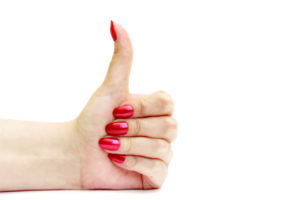
The past decade has seen a surge in the popularity of gel manicures, which are valued for their appearance and durability. There are some risks associated with these manicures, however, including skin damage from the ultraviolet light used during the curing process. If a gel manicure is performed properly with UV protection, consumers can enjoy the benefits without experiencing negative effects.
Benefits of Gel Manicures
Gel manicures have been around for a long time, said board-certified dermatologist Chris G. Adigun, MD, FAAD, but they have become more popular over the last 10 years, thanks to the development of gel formulas that are easier to apply and remove.
Today, she says, a gel manicure can be performed in nearly the same amount of time as a traditional manicure — with better results.
When applied properly, gel polish won’t chip in a few days like traditional nail polish does. As a result, a gel manicure provides the longevity and sturdiness of artificial nails without the upkeep or time commitment. “Durability is the number one benefit of a gel manicure,” she said. “Plus, no other manicure has the high shine that you get with a gel.”
A gel manicure can improve the appearance of anyone’s nails, Dr. Adigun said, but the attractive results may be especially beneficial to those whose nails are deformed or discolored because of disease or trauma. Regular nail polish may not adhere properly to a damaged nail or provide enough coverage to mask discoloration, she says, but a gel polish can do both, which makes gel manicures a good option for many patients with nail disorders. “Nails are very visible, so disfigured or discolored nails can be really embarrassing for patients, making it difficult for them to work and socialize,” Dr. Adigun said. “For many patients, a gel manicure can be life changing.”
Risks of Gel Manicures
Despite their benefits, gel manicures are not for everyone. According to Dr. Adigun, weak or brittle nails may not be able to withstand a gel manicure, particularly the acetone used during the removal process. Because a UV lamp is required to harden gel polish and bind it to the nail, it is imperative that people who are highly sensitive to UV light use a UV-protective garment to shield their exposed skin from the UV rays. UV sensitivity may be increased by genetic factors, certain medical conditions and the use of some medications and supplements.
UV exposure during gel manicures should be a concern for everyone, not just people who know they are especially UV-sensitive, because the lamps used in these manicures emit UVA rays. Although these rays don’t burn the skin like UVB rays, Dr. Adigun says, they do penetrate the skin to damage DNA and collagen, which can lead to premature aging and may increase skin cancer risk.
Some people believe that LED curing lamps provide a safer option, but this is a misconception, as these lamps also emit UVA light. Although curing lamps are used for just a short period of time during a gel manicure, research indicates that the UV rays emitted by some nail lamps are at least four times stronger than the sun’s UV rays. Moreover, some customers get gel manicures quite frequently, Dr. Adigun said, and the repeated UV exposure may have a cumulative effect, especially in people who start getting gel manicures at a young age. “The UV dose that you receive during a gel manicure is brief, but it’s intense,” she said. “Over time, this intense exposure can add up to cause skin damage.”
Other risks of a gel manicure include physical damage to the nail or separation of the nail plate from the nail bed, both of which may result from improper curing, Dr. Adigun noted. The acetone used to remove gel polish may dry out the nail, but attempting to remove the polish by physical means like scraping or chipping can cause damage, so it’s important to ensure that a gel manicure is applied and removed properly.
Precautions
In order to get the best results from a gel manicure, Dr. Adigun said it’s essential to use the correct polish with the correct curing lamp for the correct amount of time. Different curing lamps are designed for use with different polish formulas, she says, so whether the gel manicures are performed at home or in the salon, it is very important to use the gel polishes that are appropriate for the curing lamp being used. Those who utilize at-home gel manicure kits also should be sure to follow all instructions carefully, particularly in regard to curing time.
Dr. Adigun has been in contact with the U.S. Food & Drug Administration regarding the guidelines that govern the safe use of UV curing lamps, which she believes could be improved to better protect consumers. “In an ideal world, every salon would provide customers with a safe solution to shield their hands and fingers from UV radiation during a gel manicure. Until that solution exists, however, customers should be proactive about UV protection. I recommend that they use garments with an Ultraviolet Protection Factor of at least 50 and wear them for every gel manicure, but customers should be aware that UPF fabric becomes a less effective form of protection with each wash,” Dr. Adigun said.
An alternative UV protection option is to apply a broad-spectrum, water-resistant sunscreen with a Sun Protection Factor of 30 or higher at least 15 minutes before a gel manicure. Sunscreen may interfere with gel polish application, however, so Dr. Adigun recommends keeping sunscreen off the nails, which provide their own natural UV protection. “A gel manicure can give your nails a great, long-lasting look, Dr. Adigun said, “as long as it is performed properly and you shield your hands from the UV curing light.”
 Related Articles & Free Subscription
Related Articles & Free Subscription
Healthcare Providers & Professionals Glossary of Terms
Simple Steps to Protect Yourself from Skin Cancer






Comment here